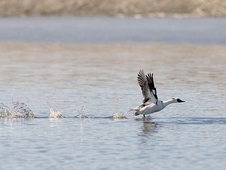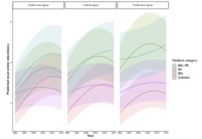
Wetlands in Europe and North Africa identified as Important Bird and Biodiversity Areas (IBAs, Key Biodiversity Areas identified for birds), particularly those that are legally protected, show consistently higher abundances of wintering waterbirds than non-IBA wetlands. As winter temperatures rise, an increasing number of waterbirds in the region are starting to overwinter further north. Therefore, regular monitoring and legally protecting currently unprotected IBAs in the north (and particularly north-east) of the region should be a conservation priority. Regular monitoring of unprotected wetlands outside the IBA network and in the south of the region is also important, as waterbirds are increasingly using unprotected wetlands and are therefore being exposed to greater threat.

Migratory waterbirds need a network of suitable wetlands to support them throughout their distributions and lifecycle. Rapid climate change is already causing spatial and phenological shifts in birds and other taxa (e.g. Amano et al. 2010, Amano et al. 2014, Chen et al. 2011, Knudsen et al. 2011, Stephens et al. 2016), making it vital to monitor local changes in abundance and expand or adapt protected areas accordingly. The International Waterbird Census, carried out every year in over 100 countries worldwide, provides invaluable long-term data on changes in local abundance of wintering waterbirds. Pavón-Jordán et al. (2020) analysed data from a 26-year period (1990–2015) to look at shifts in wintering areas of waterbirds in Europe and North Africa in relation to temperature changes, and to assess the role of existing protected areas and Important Bird and Biodiversity Areas (IBAs, Key Biodiversity Areas identified for birds) in accommodating these shifts.
Local wintering waterbird abundance increased with increasing difference in winter temperature from the mean. This association varied spatially—it was almost 10 times greater in north-east wetlands than those in the south-west. This spatial pattern may be related to the larger variability in winter weather conditions in north-east Europe. During particularly cold winters, wetlands in this region are frozen over and are therefore almost completely inhospitable, forcing waterbirds to migrate further south. During milder winters, birds are able to overwinter in more northerly areas, driving local increases in abundance. As global temperatures increase and mild winters become increasingly common, wetlands in these more northerly regions will need greater attention from monitoring schemes, and protected area networks may need to be expanded to accommodate increasing waterbird abundance.
Pavón-Jordán et al. (2020) also showed that wetlands that had been identified as IBAs (particularly those that were legally protected) consistently supported the greatest number of overwintering waterbirds throughout the study period and across all of Europe and North Africa. This was particularly evident in central and north-eastern regions. This suggests that the ecological value of the wetlands identified as IBAs has remained robust throughout the last 26 years, and highlights the importance of introducing legal protection to those which are currently unprotected. What’s more, while waterbird abundance in IBAs increased until the mid-2000s before levelling off in most regions, abundance in protected IBAs in North-East Europe continued to increase throughout the study period, suggesting that these sites have the capacity to support increasing winter numbers. As milder winters lead to more waterbirds overwintering in the north, ensuring adequate monitoring and effective protection of these sites should be a priority.
In non-IBA wetlands in the south west of the study region, waterbirds showed a shift in abundance from protected areas to non-protected areas. While the reason for this is unclear, it highlights the importance of regular monitoring at unlisted sites, as some wetlands may gain conservation importance (and hence qualify for legal protection) if abundance of overwintering birds continues to increase.
Related Case Studies in other sections
Links
International Waterbird Census
References
Amano, T., Smithers, R. J., Sparks, T. H. and Sutherland, W. J. (2010) A 250-year index of first flowering dates and its response to temperature changes. Proc. Royal Soc. B 277: 2451–2457.
Amano, T., Freckleton, R. P., Queenborough, S. A., Doxford, S. W., Smithers, R. J., Sparks, T. H. and Sutherland, W. J. (2014) Links between plant species’ spatial and temporal responses to a warming climate. Proc. Royal Soc. B 281: 20133017.
Chen, I., Hill, J. K., Ohlemüller, R., Roy, D. B. and Thomas, C. D. (2011) Rapid range shifts of species associated with high levels of climate warming. Science 333: 1024.
Knudsen, E., Lindén, A., Both, C., Jonzén, N., Pulido, F., Saino, N., Sutherland, W. J., Bach, L. A., Coppack, T., Ergon, T., Gienapp, P., Gill, J. A., Gordo, O., Hedenström, A., Lehikoinen, E., Marra, P. P., Møller, A. P., Nilsson, A. L. K., Péron, G., Ranta, E., Rubolini, D., Sparks, T. H., Spina, F., Studds, C. E., Sæther, S. A., Tryjanowski, P. and Stenseth, N. C. (2011) Challenging claims in the study of migratory birds and climate change. Biol. Rev. 86: 928–946.
Pavón-Jordán, D., Abdou, W., Azafzaf, H., Balaž, M., Bino, T., Borg, J. J., Božič, L., Butchart, S. H. M., Clausen, P., Sniauksta, L., Dakki, M., Devos, K., Domsa, C., Encarnaçao, Etayeb, K., Faragó, S., Fox, A. D., Frost, T., Guadard, C., Georgiev, V., Goratze, I., Hornman, M., Keller, V., Kostiushyn, V., Langendoen, T., Ławicki, Ł., Ieronymidou, C., Lewis, L. J., Lorentsen, S. H., Luigujoe, L., Meissner, W., Mikuska, T., Molina, B., Musil, P., Musilova, Z., Nagy, S., Natykanets, V., Nilsson, L., Pacquet, J. Y., Portolou D., Ridzon, J., Santangeli, A., Sayoud, S., Šćiban, M., Stipniece, A., Teufelbauer, N., Topić, G., Uzunova, D., Vizi, A., Wahl, J., Yavuz, K. E., Zenatello, M. and Lehikoinen, A. (2020) Positive impacts of important bird and biodiversity areas on wintering waterbirds under changing temperatures throughout Europe and North Africa. Biol. Conserv. 246: 108549
Stephens, P. A., Mason, L. R., Green, R. E., Gregory, R. D., Sauer, J. R., Alison, J., Aunins, A., Brotons, L., Butchart, S. H. M., Campedelli, T., Chodkiewicz, T., Chylarecki, P., Crowe, O., Elts, J., Escandell, V., Foppen, R. P. B., Heldbjerg, H., Herrando, S., Husby, M., Jiguet, F., Lehikoinen, A., Lindström, A., Noble, D. G., Paquet, J. Y., Reif, J., Sattler, T., Szép, T., Teufelbauer, N., Trautmann, S., van Strien, A. J., van Turnhout, C. A. M., Vorisek, P. and Willis, S. G. (2016) Consistent response of bird populations to climate change on two continents. Science 352: 84.
Compiled: 2020
Recommended Citation:
BirdLife International (2020)
Legally protected Important Bird and Biodiversity Areas have benefitted wintering waterbirds in Europe and North Africa under climate change.
Downloaded from https://datazone.birdlife.org/sowb/casestudy/legally-protected-important-bird-and-biodiversity-areas-have-benefitted-wintering-waterbirds-in-europe-and-north-africa-under-climate-change on 22/12/2024